
Table of Contents
In the business world, we focus a lot on the benefits of taking a specific action. Negotiate this contract and save 10%. Combine these two contracts into one and pay less per license. Switch from this vendor to that one and trim $10K from monthly operating expenses. The list goes on.
It’s easy to forget that non-action is a form of action. And indecision is, indeed, a type of decision.
Taking action can lead to cost savings or cost avoidance. On the other hand, failing to take any action could cost you millions of dollars. This is especially true in the world of SaaS Management. The longer you maintain the status quo, the greater the cost.
Let’s explore the cost of inaction and how you can take action to avoid those unnecessary costs.
Why SaaS Inaction Is a Problem
Ignoring SaaS Management isn’t just a passive decision—it’s an active financial and operational risk. As SaaS adoption continues to accelerate, failing to manage it effectively leads to rising costs, security gaps, and inefficiencies that impact business agility.
Organizations that take a reactive approach to SaaS often find themselves:
 Losing control over decentralized spending. When IT isn’t involved, different teams or employees purchase software independently, often without visibility into existing tools. This leads to duplicate spending and weakens negotiation power at renewal time.
Losing control over decentralized spending. When IT isn’t involved, different teams or employees purchase software independently, often without visibility into existing tools. This leads to duplicate spending and weakens negotiation power at renewal time.- Wasting money on inactive licenses. Without proactive license optimization, businesses pay for software that goes unused. Across the average SaaS portfolio, 53% of licenses sit idle, amounting to $21M in annual wasted spend.
- Falling behind on compliance and security standards. A lack of governance over SaaS means shadow IT expands unchecked, leading to unvetted applications that don’t meet security or regulatory requirements.
The Compounding Effects of Inaction
The longer an organization delays action, the greater the long-term financial and operational impact. Unmanaged SaaS portfolios lead to:
Siloed Data and Reduced Productivity
When teams use multiple tools with similar functions, it creates inefficiencies across your business. Data becomes fragmented across platforms, as there’s little to no IT oversight to ensure systems are integrated. As a result, teams and individuals don’t have the full picture to make sound decisions. Productivity and collaboration also suffer because people are working from different tools.
Auto-Renewals Locking in Bad Contracts
Without visibility into renewal dates and contract terms, companies miss opportunities to renegotiate, often paying 20-30% more than necessary on renewals. Considering that organizations experience an average of 247 renewals per year, and that adds up quickly.
Increasing and Hidden Security Gaps
The average company has 33.6% of applications acquired by employees, outside of IT’s control—many of which have poor security ratings. Each of these applications represents a potential compliance or data breach risk. Gartner analysts also predict that, through 2027, organizations that fail to centrally manage SaaS life cycles will remain five times more susceptible to a cyber incident or data loss.
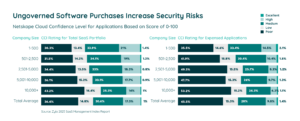
A Delayed Response Increases Costs
For every month that an organization delays addressing SaaS waste and inefficiencies, more money is lost, and risks continue to grow. Without a dedicated SaaS Management approach, organizations will struggle to:
- Eliminate redundant applications and consolidate spend.
- Identify cost-saving opportunities within their current SaaS investments.
- Protect company data and maintain compliance with evolving regulations.
SaaS inaction isn’t just an oversight—it’s an ongoing cost that scales with every new application added to the portfolio. Organizations that act now can regain control, optimize their software investments, and drive measurable financial and operational improvements.
2024 Gartner® Magic Quadrant™ for SaaS Management Platforms
SaaS Inaction Is Costing You More Than You Think
If your SaaS portfolio is growing rapidly, you’re not alone. Most organizations are seeing expansion driven by business units and individual employees making decentralized purchases. However, this growth often goes unchecked without a clear management strategy.
The real question is: What’s the financial impact of inaction? The answer isn’t pretty. Uncontrolled SaaS spending leads to massive inefficiencies, and costs pile up in ways many organizations fail to recognize until it’s too late.
SaaS License Waste
Depending on your organization’s size and annual spend, failing to act on SaaS license waste could cost you anywhere from $1.9M to $127M annually. On average, companies are now wasting $21M annually on unused licenses alone.
That’s a staggering number, but let’s break it down further:
- 53% of software licenses go unused, meaning more than half of your SaaS investment isn’t delivering value.
- The average organization spends $49M on SaaS annually, yet a significant portion of this budget is tied up in software that employees don’t use.
- Shadow IT is a growing concern, accounting for 3.8% of total SaaS spend and 33.6% of applications.
The numbers for a small enterprise with 2,501-5,000 employees become even starker. This size organization typically spends $62.9M annually on SaaS, with 44% of licenses going unused. If we subtract the recommended 10% buffer for ideal utilization, the actual waste comes out to 34% of the total SaaS spend. That means a yearly average of $21.4M in wasted funds.
This waste increases significantly at scale. For larger enterprises, inaction on SaaS Management can cost well over $100M per year. The chart below highlights how much these costs escalate based on company size.
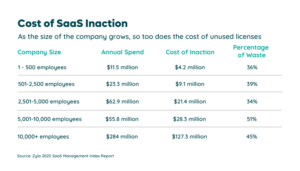
The bottom line? Without intervention, organizations will continue spending millions on unused software—money you could reallocate to drive real business value.
Application Redundancy
SaaS portfolios often contain multiple applications that serve the same function. Whether it’s due to decentralized purchasing or teams preferring different tools, application redundancy leads to unnecessary spending and operational inefficiencies.
Some of the most redundant application categories include online training classes, project management, and team collaboration tools. Across these categories alone, our data shows that organizations have the potential to save between $477K and $2.8M annually by eliminating some of those applications and standardizing to fewer software titles.

Without a centralized approach to SaaS Management, these redundant applications remain hidden in plain sight, creating layers of inefficiencies. For instance, data becomes siloed and fragmented, productivity and collaboration suffer, and IT’s administrative burden increases the more apps you have.
By identifying overlapping tools, businesses can rationalize their software stack, negotiate better pricing, and optimize spending—all without sacrificing productivity.
Long Tail Applications
While business-critical SaaS tools dominate IT budgets, long-tail (lower-cost, niche) applications can add up to significant costs. These often unmonitored applications contribute to shadow IT, security risks, and operational inefficiency. Many go underutilized, with licenses that renew automatically—often without scrutiny.
You may be saying, “A $2,000 per year app here and there doesn’t sound like much.” You’re right. To manage software spending holistically, you need the bigger picture.
The 2025 SaaS Management Index shows that the average company has $41M to $55.5M in addressable long-tail spending. Meanwhile, large enterprises face an even larger range of $127.5M to $175.9M. This range represents the bottom 50% to 65% of SaaS spend, ordered by highest to lowest cost.

It’s important to note that there’s no universal standard as to what is considered long tail. The criteria you use to qualify apps as long tail depends on your organization’s size and complexity, procurement policies, and risk tolerance—among other factors.
By addressing longtail SaaS spend, your organization can:
- Manage total spend more holistically
- Find opportunities to rationalize redundancies and duplicative apps (read: cost savings)
- Scale SaaS Management across your organization
- Improve software governance
The Growth of SaaS Will Increase the Cost of Inaction
SaaS adoption shows no signs of slowing down, and as it expands, so too does the financial risk of inaction. Organizations are rapidly shifting from traditional on-premises software to cloud-based solutions, with SaaS becoming the dominant model for software delivery.
In some cases, companies are making this transition by choice—drawn in by SaaS’s convenience, flexibility, and affordability. In others, the shift is being forced by software vendors themselves. By 2026, Gartner predicts that most of the top 20 software vendors will sunset sales of new perpetual software, effectively requiring businesses to migrate to SaaS or subscription-based offerings. This shift alone is expected to increase software costs by at least 35%.
The financial impact is already being felt. SaaS remains the largest segment of the cloud market by end-user spending, with Gartner projecting global SaaS spending to grow 19.2% to $299B in 2025, up from $247B in 2024.

Beyond rising costs, the rapid expansion of SaaS within organizations creates new challenges in visibility and control. Our latest report shows that the average organization sees 7.6 new unique applications added to its environment every month—91 annually. This amounts to an average portfolio growth rate of 33.2% per year, further compounding the risks of unmanaged SaaS sprawl.
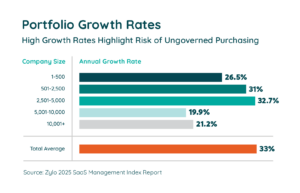
SaaS is here to stay, and its footprint will only continue to grow. The longer businesses wait to optimize their SaaS portfolios, the greater the cost—both in wasted spend and missed opportunities for efficiency.
It’s Time to Optimize Your SaaS Portfolio
There’s no denying the high cost of inaction when it comes to SaaS Management. Yet, optimizing your SaaS portfolio is often easier said than done. The challenge? SaaS isn’t purchased, delivered, accessed, or used like traditional software, making cost optimization methods manually intensive and time-consuming.
One of the biggest obstacles to optimization is how SaaS is purchased. Unlike on-premises software, which is typically funneled through IT, SaaS is incredibly easy to buy. Often, it requires nothing more than an employee inputting a credit card number and submitting the expense for reimbursement later.
This ease of purchase has led to widespread decentralized spending, where teams and individuals across the organization acquire SaaS independently. Today, our data shows that IT is responsible for just 26% of total SaaS spend and 16% of applications. The remaining is led by business units and individual employees.
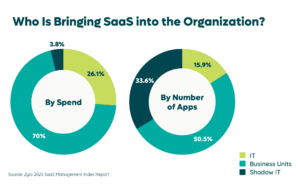
This fragmented purchasing approach creates significant inefficiencies—from duplicate subscriptions to underutilized licenses and missed opportunities for negotiation. Without visibility and governance, companies end up paying for tools they don’t need, failing to leverage volume discounts, and struggling with renewal processes that could otherwise lead to cost savings.
Clearly, SaaS presents challenges, but it also offers massive opportunities for optimization. The key to unlocking these opportunities lies in a structured SaaS Management practice, powered by a dedicated SaaS Management platform—one that provides full visibility, eliminates waste, and ensures every dollar spent on software drives value.
Take the First Step: Gain Full Visibility into All SaaS
SaaS Management is a proven way to reduce and avoid costs—just see the results our customers have seen. But optimizing your SaaS portfolio doesn’t mean tackling everything at once. The best approach is to start with visibility, because you can’t manage or optimize what you don’t know exists.
The first step in any SaaS Management strategy is to gain full visibility into all applications in use across your organization. This includes software purchased by:
- IT teams
- Business units
- Individual employees
What you uncover may be surprising. The average organization now has 275 SaaS applications and spends $49M annually on SaaS. However, IT leaders often underestimate their application quantity by 1.7X and their actual SaaS spend by 3X. This miscalculation results in unchecked spending, redundant applications, and lost opportunities for cost control.

And visibility isn’t a one-time effort. SaaS portfolios are highly dynamic, with applications constantly being added or removed. On average, 7.6 new applications enter a company’s SaaS environment every month—91 annually. Without real-time insight, organizations will struggle to track usage, control costs, and optimize their investments.
Beyond discovering which applications exist, it’s just as important to understand how much is spent and how each tool is used. Spend and usage insights reveal optimization opportunities, including:
- Rightsizing licenses to match actual usage
- Securing the best pricing and contract terms
- Renewing with confidence, backed by data
Many organizations attempt to track their SaaS manually—often relying on spreadsheets. However, with the scale and complexity of modern SaaS environments, manual methods fall short. If you want real visibility into your SaaS portfolio—automatically and continuously—you need a dedicated SaaS Management platform that enables full discovery and ongoing optimization.
The Definitive Guide to SaaS Management
Don’t Settle for the (Costly) Status Quo: Now’s the Time to Take Action to Manage SaaS
Choice is the ability to make a decision when you have two or more possibilities. But remember: choosing not to take action is a choice, and it will cost you.
If you want to optimize SaaS spend, you have at least a few million reasons to take action.
- $1.9M to $127M in license waste, depending on the size of your company
- $477K and $2.8M average potential savings by removing redundant apps
- $41M to $55.5M average addressable longtail spend
While non-action may make sense in some cases, not managing your SaaS estate isn’t one of them. Learn how to break the status quo, overcome inaction, and start managing your SaaS costs.
Learn how Zylo’s Discovery Engine can help you get started by giving you visibility into all your SaaS. Or, see it in action by requesting a demo with our team of experts.


‘Oh Shit’ Moments that Validate the Need for SaaS Management
Table of Contents ToggleOh Shit! I’m Wasting MoneyOh Shit! We Have...

10 Ways Zylo Helps You Save Money on Software
Table of Contents ToggleWhy SaaS Inaction Is a ProblemThe Compounding Effects...


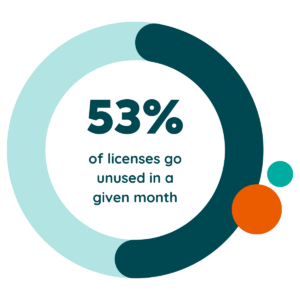 Losing control over decentralized spending.
Losing control over decentralized spending. 
